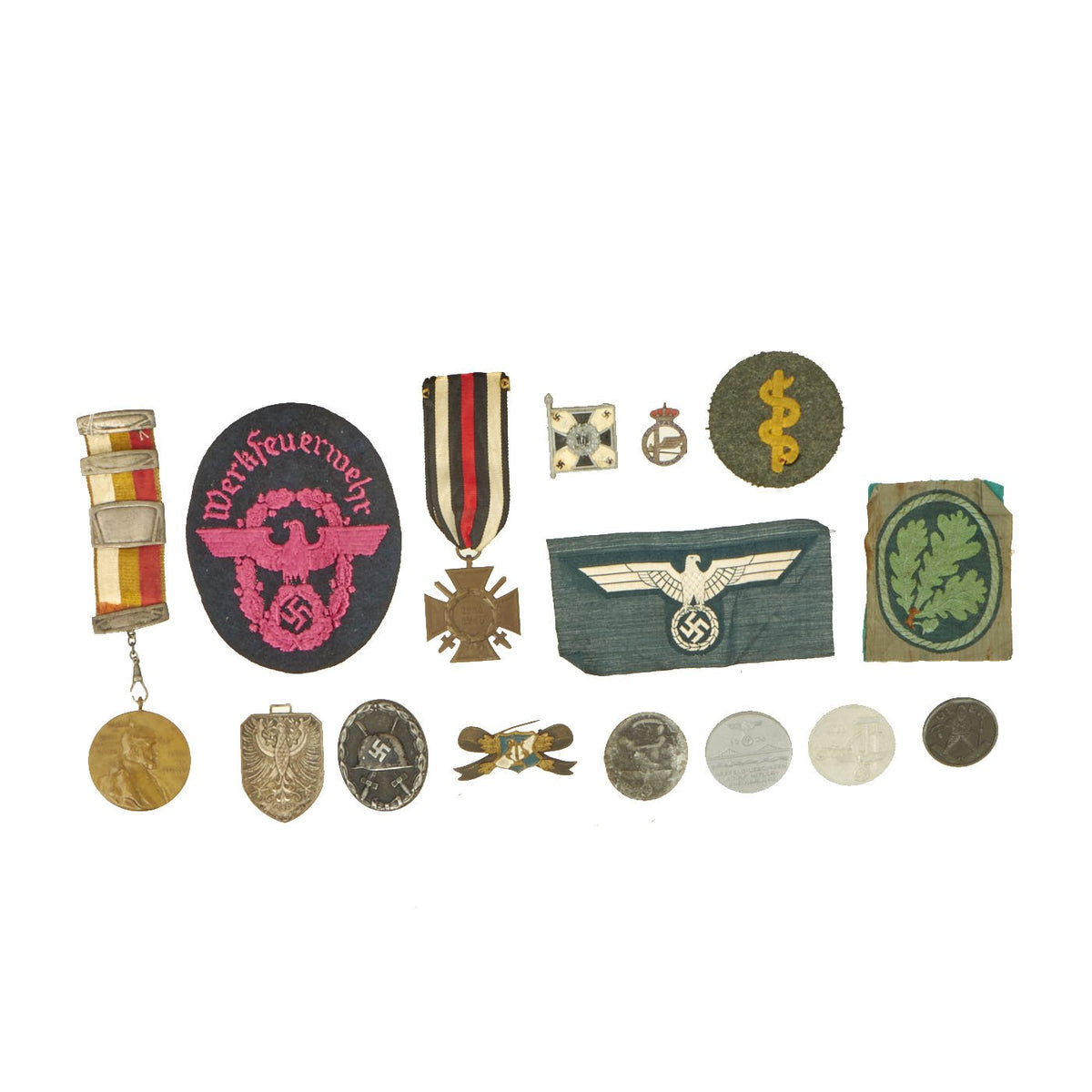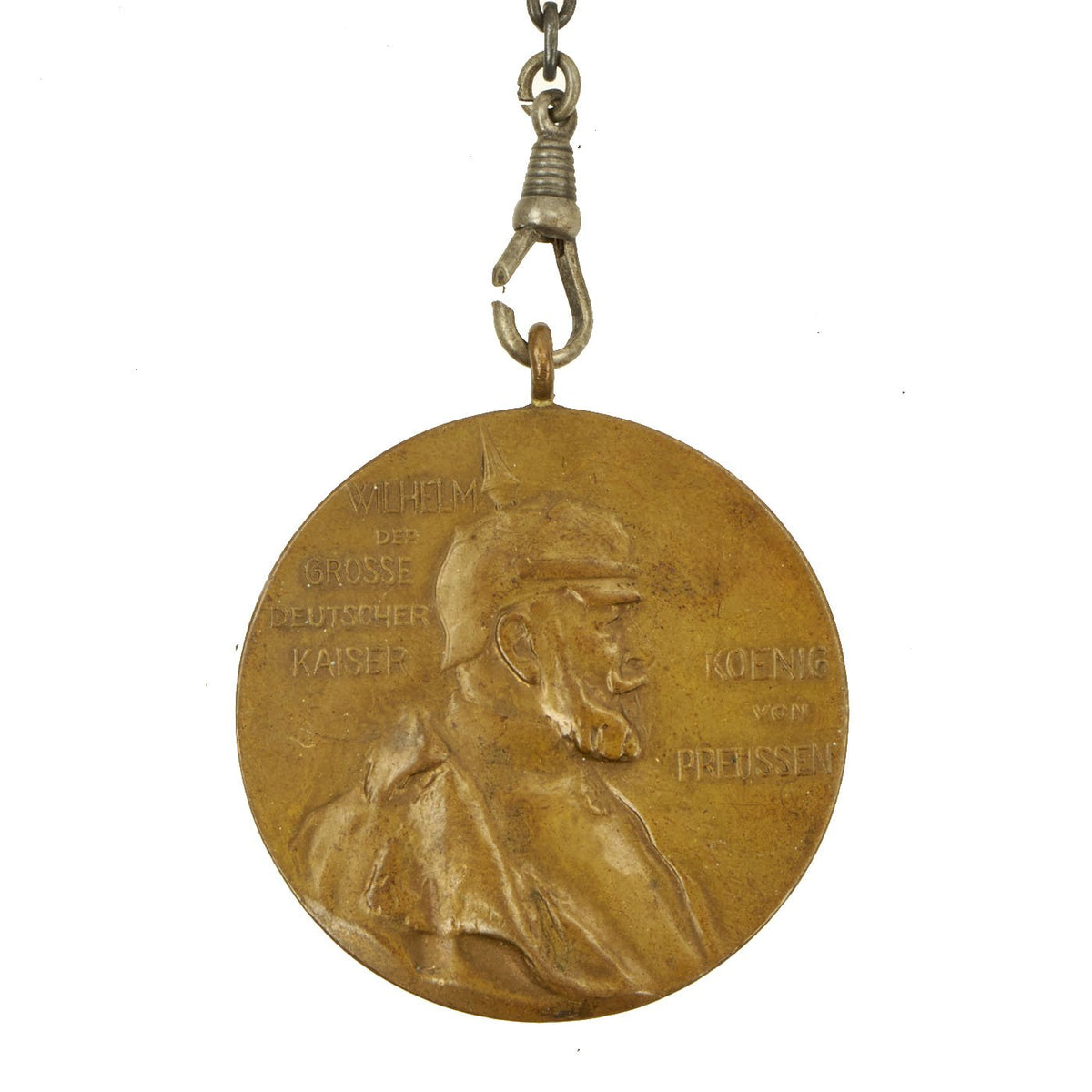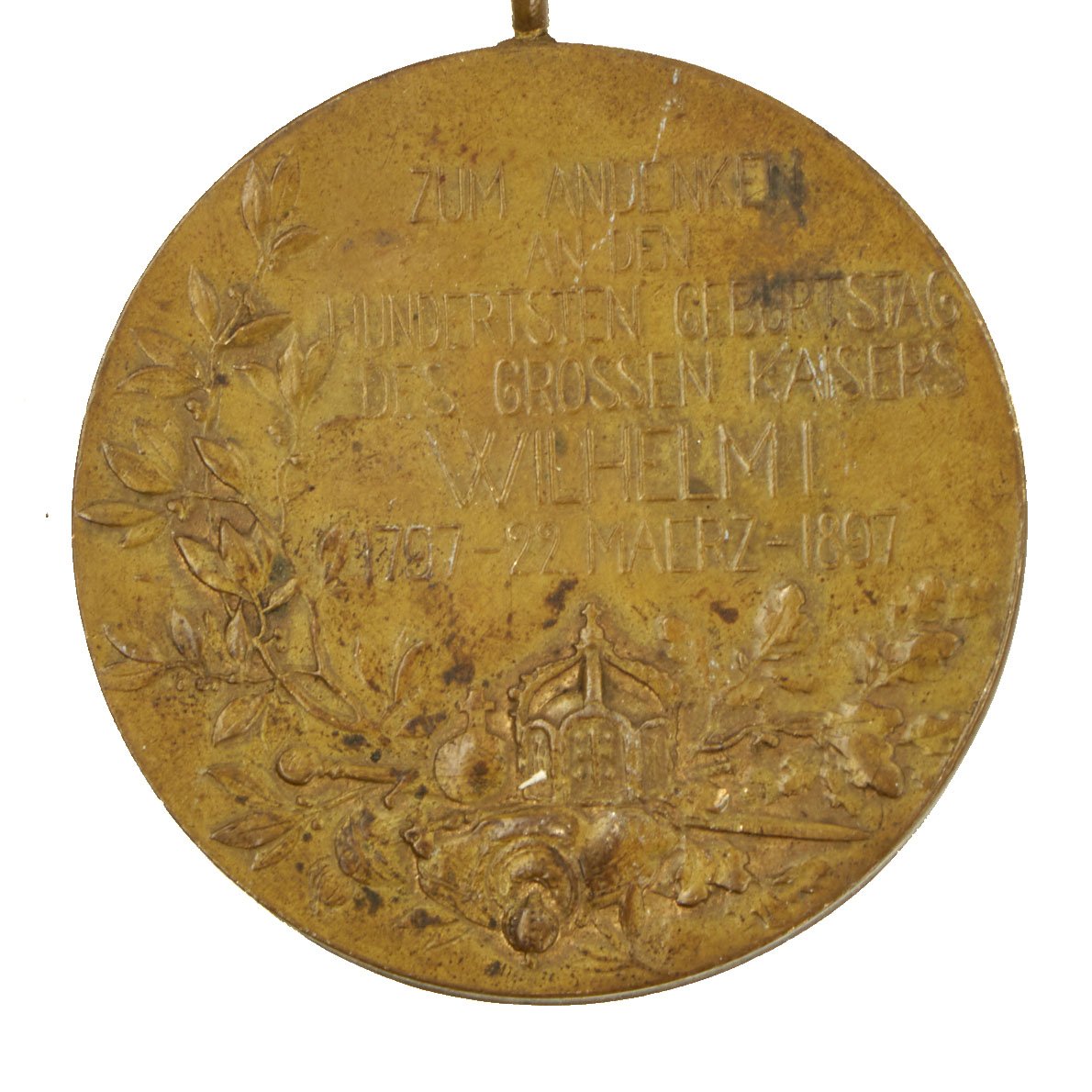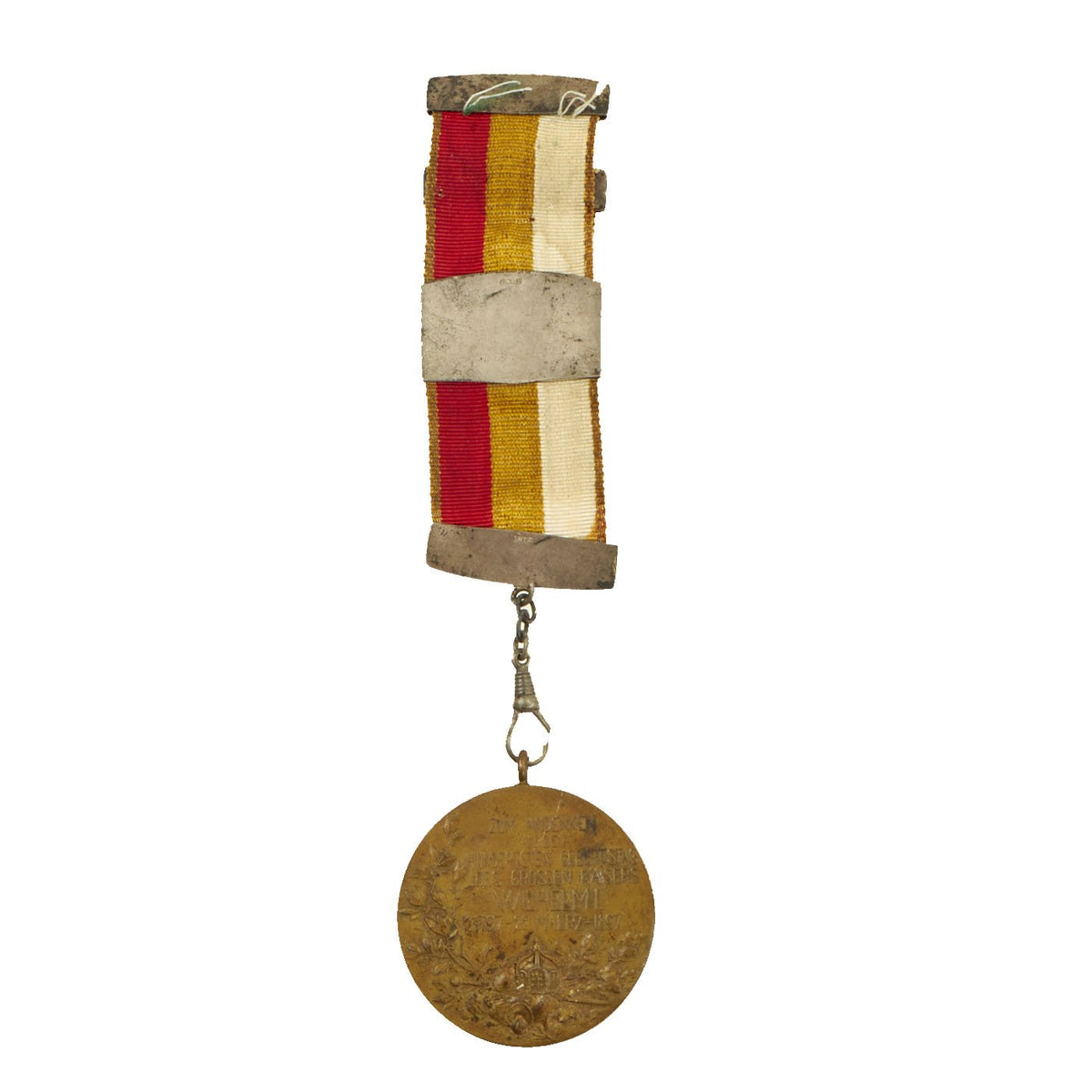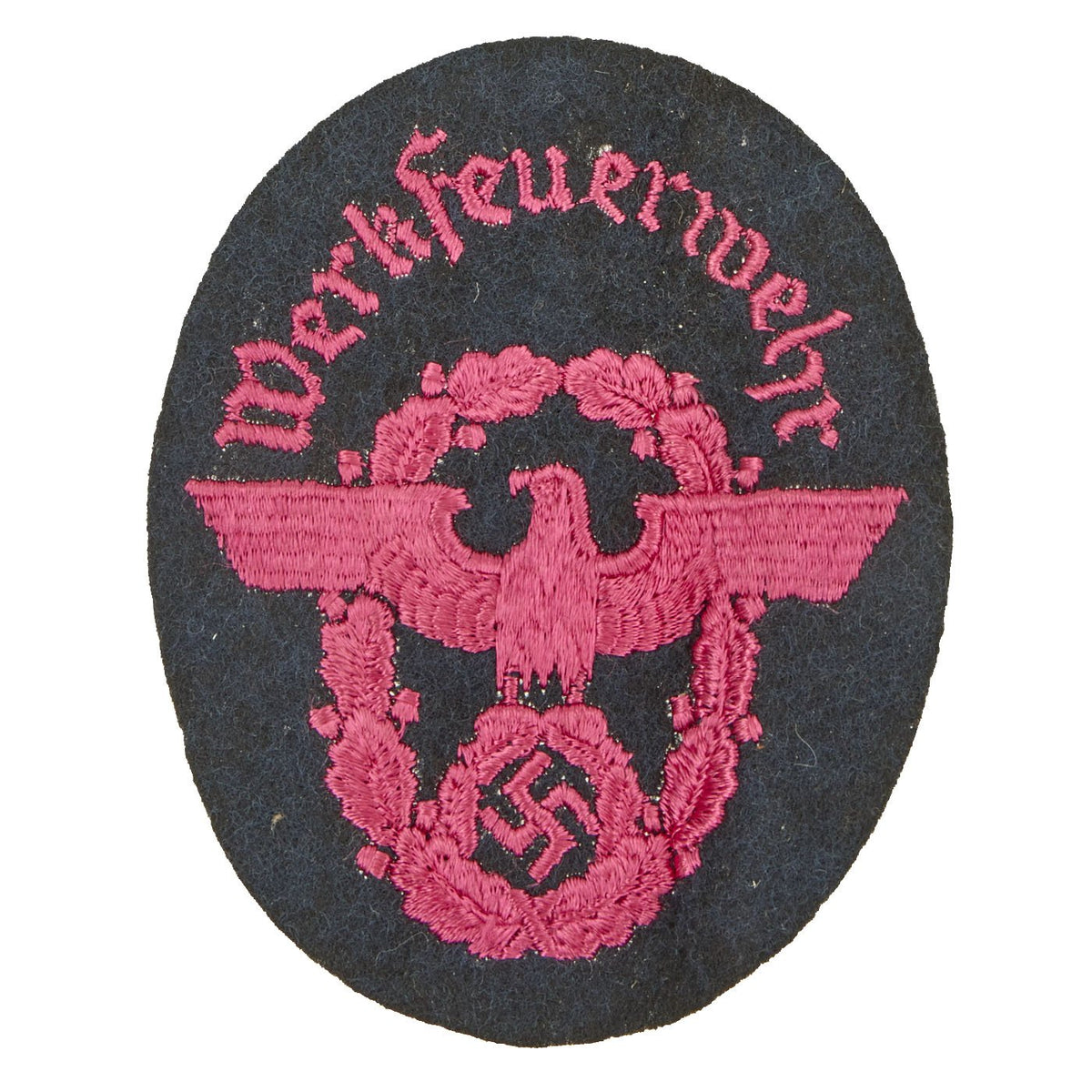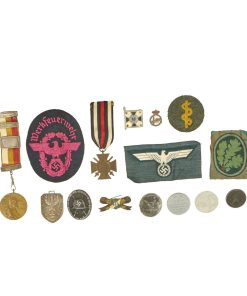Original German WWI & WWII Medal and Insignia Grouping with Hindenberg Cross & Wound Badge – 15 Items Original Items
$ 295,00 $ 118,00
Original Items: Only One Set Available. This is a very nice collection of German WWII Insignia & Awards, which was brought back from the European theater by a USGI after the war was concluded. It includes some a wide variety of medals and insignia, including a Hindenberg Cross, a Black Wound Badge, a Kaiser Wilhelm I Centennial Medal, and more!
This lovely set includes:
– One Pre-WWII German WWI Honor Cross of the World War 1914/1918 (Hindenburg Cross) Medal attached to the correct tri-color ribbon clip. It is maker marked C.P. on the back.
– One Pre-WWI Imperial German Kaiser Wilhelm I Memorial Medal aka Centenary Medal 1897, complete with long ribbon hanger.
– One German WWII Hollow Back 3rd Class Wound Badge in Black. It is in very good condition, and is made from stamped steel.
– One German WWII Heer Army Enlisted Medical Personnel (Sanitätsunterpersonal) Specialist Badge, a yellow embroidered Staff of Aesclepius on a field gray background.
– One German WWII Feuerschutzpolizei (Fire Protection Police) NCO Sleeve Eagle, Pink on a dark Navy Blue Background. This insignia is specially for Werkfeuerwehr (Factory Fire Brigade) issue, responsible for putting out fires at factories.
– One German WWII Gebirgsjäger (Mountain Trooper) BEVO embroidered sleeve badge, glued to a green fabric backing.
– One German WWII Heer Army BEVO embroidered Wehrmachtadler Breast Eagle, white on dark blue green. Unissued.
– One Small Plastic German WWII Army Heer Infantry Standard.
– One Small Italian Air Force Badge.
– One Bavarian Musician Tinnie.
– FIVE German Interwar Era Event Tinnies
A wonderful totally genuine grouping perfect for the German Medal and Insignia collector.
Hindenburg Cross with Crossed Swords (for combat):
The Honor Cross of the World War 1914/1918 (German: Das Ehrenkreuz des Weltkriegs 1914/1918), commonly, but incorrectly, known as the Hindenburg Cross was established by Field Marshal Paul von Hindenburg, President of the German Republic, by an order dated 13 July 1934, to commemorate the distinguished deeds of the German people during the First World War. This was Germany’s first official service medal for soldiers of Imperial Germany who had taken part in the war, and where they had since died it was also awarded to their surviving next-of-kin. Shortly after its issuance, the government of NSDAP Germany declared the award as the only official service decoration of the First World War and further forbid the continued wearing of German Free Corps awards on any military or paramilitary uniform of a state or NSDAP Party organization.
The German Wound Badge (Verwundetenabzeichen) was instituted during the First World War to recognize those wounded in the conflict. It was designed using a World War One style Imperial German helmet as the main motif. The helmet was set on top two crossed swords against a pebbled background and surrounded by a laurel leaves wreath.
At the outbreak of war in September 1939 with Poland, Adolf AH once again reinstated the Wound Badge Award. Again the pattern of the badge was similar to that of the earlier style except the new design was freshened up a bit by using an M35 pattern German helmet and a slightly softer looking wreath. This pattern was used until the end of the war in 1945. It is impossible to know the exact numbers of wound badges awarded during the course of the Second World War due to the vast scale and countless individuals who were wounded or killed in the conflict.
The Wound Badge Awards came in three different types of grades representing the amount , or severity, of wounds received. The first grade, the Black Wound Badge was awarded for 1 to 2 wounds received in combat. The Silver Grade was awarded for 3 to 4 wounds, and finally the Gold Grade for 5 or more wounds, total disability, or death.
Kaiser Wilhelm Memorial Medal
The Kaiser Wilhelm Memorial Medal also known as the Centenary Medal (German: Kaiser-Wilhelm-Erinnerungsmedaille Zentenarmedaille) was established on March 22, 1897 by Wilhelm II on the occasion of the 100th Birthday of his grandfather, Emperor Wilhelm I.
The medal was awarded by Prussia to state and university officials, as well as all military officers, non-commissioned officers and enlisted personnel, which were actively serving in army, navy and Schutztruppe. Medals were also awarded to the surviving veterans of the First Schleswig War, Second Schleswig War, Austro-Prussian War, and the Franco-Prussian War. The medal is made of bronze gunmetal from captured cannon. It is 40 mm in diameter and was suspended from a ribbon 36 mm wide.
The obverse is a right facing effigy of Wilhelm I in military uniform wearing a mantle and Pickelhaube. To the left of the effigy is the inscription WILHELM / DER / GROSSE / DEUTSCHE / KAISER (William the Great German Emperor). To the right is KOENIG / VON / PREUSSEN (King of Prussia).
The reverse depicts symbols of royal authority including the German State Crown, an orb, sword, and scepter placed upon a pillow surrounded by oak leaves, in the lower half of the medal. To the left is an upward climbing laurel branch. In the upper half is the inscription in six lines ZUM ANDENKEN AN DEN HUNDERTSTEN GEBURTSTAG DES GROSSEN KAISERS WILHELM I. 1797 22.MAERZ 1897 (IN MEMORY OF THE HUNDREDTH BIRTHDAY THE GREAT EMPEROR WILHELM I. 1797–MARCH 22–1897).
Fast Shipping with Professional Packaging
Thanks to our longstanding association with UPS FedEx DHL, and other major international carriers, we are able to provide a range of shipping options. Our warehouse staff is expertly trained and will wrap your products according to our exact and precise specifications. Prior to shipping, your goods will be thoroughly examined and securely secured. We ship to thousands clients each day across multiple countries. This shows how we're dedicated to be the largest retailer on the internet. Warehouses and distribution centres can be located throughout Europe as well as the USA.
Note: Orders with more than one item will be assigned a processing date depending on the item.
Before shipping before shipping, we'll conduct a thorough inspection of the items you have ordered. Today, the majority of orders will be delivered within 48 hours. The delivery time will be between 3-7 days.
Returns
The stock is dynamic and we cannot completely manage it because multiple stakeholders are involved, including our factory and warehouse. So the actual stock may alter at any time. It's possible that you may not receive your order once the order has been made.
Our policy is valid for a period of 30 days. If you don't receive the product within 30 days, we are not able to issue a refund or an exchange.
You can only return an item if it is unused and in the same state as the day you received it. You must have the item in its original packaging.
Related products
Uncategorized
Uncategorized
Uncategorized
Uncategorized
Uncategorized
Uncategorized
Uncategorized
Uncategorized
Armoured Fighting Vehicles of the World: AFVs of World War One (Hardcover Book) New Made Items
Uncategorized
Uncategorized
Uncategorized
Uncategorized
Band of Brothers ORIGINAL GERMAN WWII Le. F.H. 18 10.5cm ARTILLERY PIECE Original Items
Uncategorized
Uncategorized
Australian WWII Owen MK1 Machine Carbine SMG Custom Fabricated Replica with Sling Original Items
Uncategorized
Uncategorized
Uncategorized
Uncategorized
